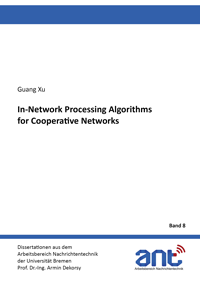
Shop : Details
Shop
Details
49,80 €ISBN 978-3-8440-7270-9Softcover242 pages61 figures359 g21 x 14,8 cmEnglishThesis
March 2020
Guang Xu
In-Network Processing Algorithms for Cooperative Networks
The dissertation is about distributed algorithms for cooperative processing among collaborated nodes within a network (In-Network Processing (INP)). The main content is mainly focused on the novel INP algorithms development of distributed signal processing that are applied to cooperative networks like the mobile communications networks or wireless sensor networks. For the distributed applications, the INP can generally provide solutions to distributed inference problems based on measurements of physical, medical, biological chemical sensors in wireless sensor networks, in addition, the INP can also facilitate distributed signal processing for distributed radio access networks in 5G/6G communications system.
In this dissertation, a variety of distributed algorithms under the framework of INP have been provided. These INP algorithms are designed for application scenarios where joint processing tasks are executed by cooperated entities in wireless communications networks through a distributed and parallel fashion. In particular, two main areas the distributed consensus-based joint estimation for signal detection and distributed joint precoding for signal transmission in communications networks are highly focused on and investigated in this dissertation.
The INP algorithms for distributed consensus-based joint estimation are applied to the scenario where a group of nodes receive signals from common users, and those receive nodes aim to collaborate to estimate the received signals in a distributed way, such that all receive nodes can eventually achieve same estimates on the user signals. To develop the INP algorithms for distributed consensus-based joint estimation, several numerical approaches like Lagrangian dual method and alternating direction method of multipliers have been investigated in order to solve for corresponding constrained optimization problems in a distributed way. In addition, some novel approaches like the virtual clustering as well as consensus-achieving filtering approaches have also be invented to improve the performance with low communication overhead and low computation complexity during the cooperative processing. Moreover, the INP algorithms for the distributed joint precoding are applied to another scenario where a group of nodes cooperate to perform joint transmission to target users in order to avoid interference at the receivers. Correspondingly, by exploiting advanced numerical approaches for distributed implementation of joint signal processing like two-step Jacobi and pre-conditioned Richardson methods, several types of INP algorithms for distributed joint precoding with low communication effort and low computation complexity have been developed. Meanwhile, different transmit power constraints are also taken into account for the development of different distributed precoding algorithms to cope with different practical system requirements.
Overall, this work not only presents a variety of concrete INP algorithms for distributed processing in communication networks, it also provides novel ideas and deep analysis of the INP approaches and techniques that can be applied to a wide range of applications for distributed joint processing in cooperative networks.
In this dissertation, a variety of distributed algorithms under the framework of INP have been provided. These INP algorithms are designed for application scenarios where joint processing tasks are executed by cooperated entities in wireless communications networks through a distributed and parallel fashion. In particular, two main areas the distributed consensus-based joint estimation for signal detection and distributed joint precoding for signal transmission in communications networks are highly focused on and investigated in this dissertation.
The INP algorithms for distributed consensus-based joint estimation are applied to the scenario where a group of nodes receive signals from common users, and those receive nodes aim to collaborate to estimate the received signals in a distributed way, such that all receive nodes can eventually achieve same estimates on the user signals. To develop the INP algorithms for distributed consensus-based joint estimation, several numerical approaches like Lagrangian dual method and alternating direction method of multipliers have been investigated in order to solve for corresponding constrained optimization problems in a distributed way. In addition, some novel approaches like the virtual clustering as well as consensus-achieving filtering approaches have also be invented to improve the performance with low communication overhead and low computation complexity during the cooperative processing. Moreover, the INP algorithms for the distributed joint precoding are applied to another scenario where a group of nodes cooperate to perform joint transmission to target users in order to avoid interference at the receivers. Correspondingly, by exploiting advanced numerical approaches for distributed implementation of joint signal processing like two-step Jacobi and pre-conditioned Richardson methods, several types of INP algorithms for distributed joint precoding with low communication effort and low computation complexity have been developed. Meanwhile, different transmit power constraints are also taken into account for the development of different distributed precoding algorithms to cope with different practical system requirements.
Overall, this work not only presents a variety of concrete INP algorithms for distributed processing in communication networks, it also provides novel ideas and deep analysis of the INP approaches and techniques that can be applied to a wide range of applications for distributed joint processing in cooperative networks.
Keywords: Distributed Signal Processing; Cooperative Processing; Communications Networks; Wireless Sensor Networks; Constrained Optimization Problem
Dissertationen aus dem Arbeitsbereich Nachrichtentechnik der Universität Bremen
Edited by Prof. Dr.-Ing. Armin Dekorsy, Bremen
Volume 8
Available online documents for this title
You need Adobe Reader, to view these files. Here you will find a little help and information for downloading the PDF files.
Please note that the online documents cannot be printed or edited.
Please also see further information at: Help and Information.
Please also see further information at: Help and Information.
| Document |  | Document | ||
| Type |  | |||
| Costs |  | 37,35 € | ||
| Action |  | Purchase in obligation and download the file | ||
| Document |  | Table of contents | ||
| Type |  | |||
| Costs |  | free | ||
| Action |  | Download the file | ||
User settings for registered online customers (online documents)
You can change your address details here and access documents you have already ordered.
User
Not logged in
Export of bibliographic data
Shaker Verlag GmbH
Am Langen Graben 15a
52353 Düren
Germany
Am Langen Graben 15a
52353 Düren
Germany
Mon. - Thurs. 8:00 a.m. to 4:00 p.m.
Fri. 8:00 a.m. to 3:00 p.m.
Fri. 8:00 a.m. to 3:00 p.m.
Contact us. We will be happy to help you.



